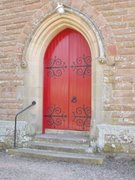 While we are on the subject of the moon we are cross posting a wondeful article by Mike Gormley.
While we are on the subject of the moon we are cross posting a wondeful article by Mike Gormley. The pictures are our addition to the post.
Painting by Giovanni Battista TiepoloWhy is the moon the perfect symbol for Mary?
This is what I often ask college, senior and junior high school students.
Some answers are: "It is beautiful", "it shines in the darkness", or "because it is round" (I don't understand that last one, but it is surprisingly popular) .
None of these answers captures the reality of why the moon and Mary have one thing so wonderfully in common, so I changed the question to:
Where does the moon get its light?
"From the sun!" Everyone hurries to yell out that answer. The moon is a rock, not a star, and so it does not produce its own light at all, though compared with all of the other stars of night, the moon is the sky's brightest luminary. No, the entire glory of the moon, her splendid radiance, is not her own, but is rather the sun's light reflecting off the surface and onto us. The moon is gloriously luminous because it reflects the sun's rays.
I ask again,
So why is the moon the most perfect symbol for Mary?
With this new realization the answer I was looking for clicks in their minds as hands are raised and impatient voices call out: "Because Mary reflects her Son!" 
And this is the whole of it. . . . few are holy enough to do all things for God's greater glory. Mary is not a saint in spite of her Son or instead of her Son, she is so glorious to the Catholic mind and heart because she is so much like her Son. Her light will always be borrowed light, reflected light because she has most fully surrendered herself to God in saying "Yes" to the conception, birth, and raising of the Son of God.
I honor great people. One of my favorite heroes is Don John of Austria, the last knight of Europe, who led Christian Europe's Holy Alliance in 1571 to defeat once and for all time the Turkish naval threat on the Mediterranean Sea. He was simple, courageous, humble and fierce and I celebrate his memory with honor. Ultimately, I honor Don John of Austria because he was a Christian soldier who fought with nobility. Everyone honors great deeds and great people.
How much more so should we honor the one who's "yes" brought about the incarnation of the Son of God? The Father is a gentleman; he lowered himself to ask his little creature to assent to his plan and allow his Son to be conceived and born and live a human life. We need to realize that the greatest honor belongs to the greatest people who do great things for God's glory. Many are victorious in giving themselves honor and winning glory, but few are holy enough to do all things for God's greater glory. And this is why we turn our minds to Mary.
 The drawing to the left was done by Albrecht Durer
The drawing to the left was done by Albrecht DurerNo Catholic worships her, for worship (or adoration) belongs to God alone, Father, Son and Spirit. However, Mary was the first disciple, the greatest daughter of Israel and the living icon of the Church who never stopped, never once dimmed in her reflection of the Son of Righteousness, of her Son. This is why she not only deserves honor, but she deserves the highest of honors, the greatest of venerations. What makes her so great is that she is so transparent and whenever you look at her with the eyes of faith, hope and love, you see Jesus.
To honor her as the Mother of God is to worship Jesus Christ as the Son of God. To venerate her as the Immaculate One is to adore him as the Lamb of God who takes away the sin of the world.
So pray the rosary tonight realizing that in honoring Mary you are worshipping God.
__________________________________________________________________
Great article, Mike "Gomer" Gormely!
Gomer is our youth minister. He is also a graduate of Franciscan University of Steubenville.
 On Thursday, May 31, 2007 there is going to be Blue Moon!
On Thursday, May 31, 2007 there is going to be Blue Moon!

























































